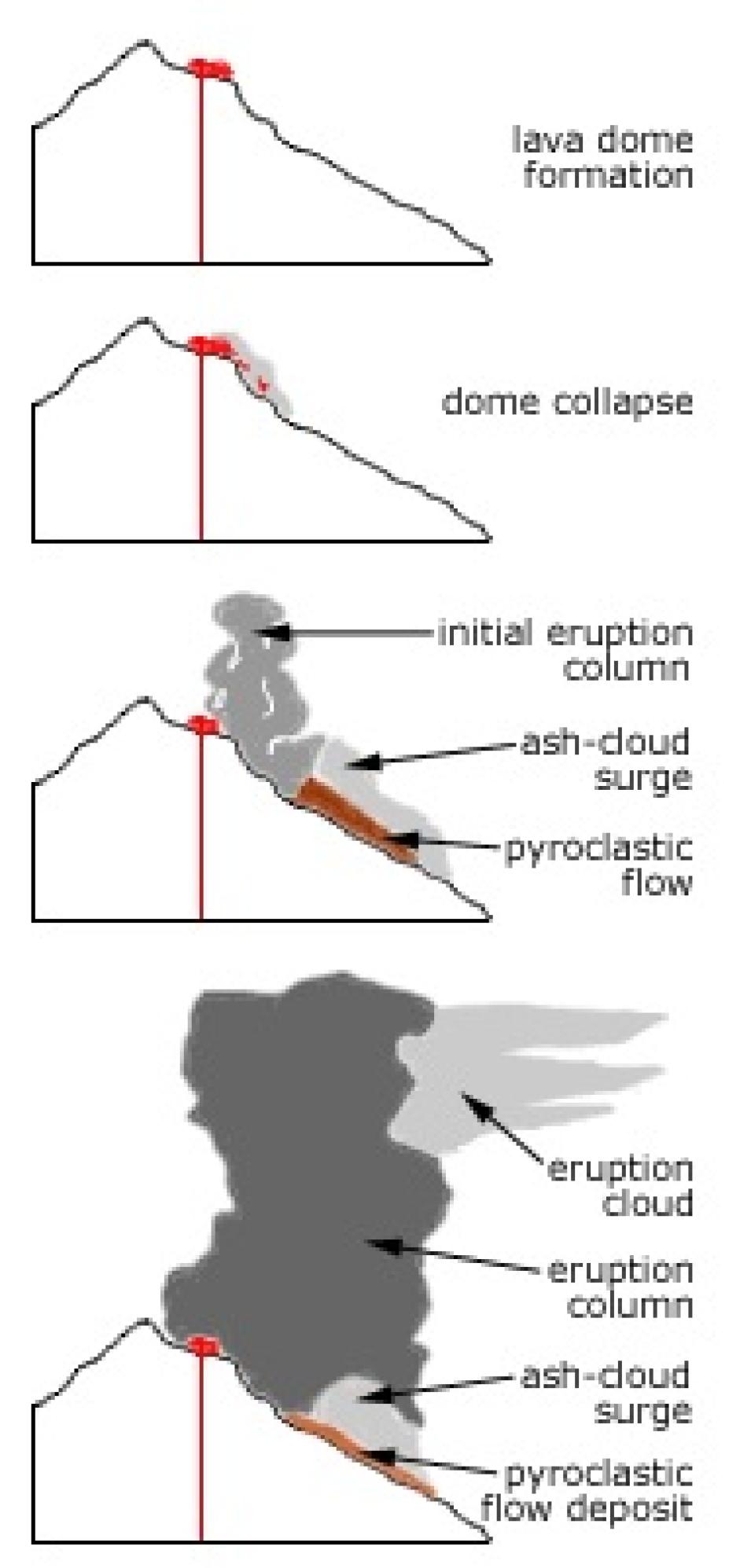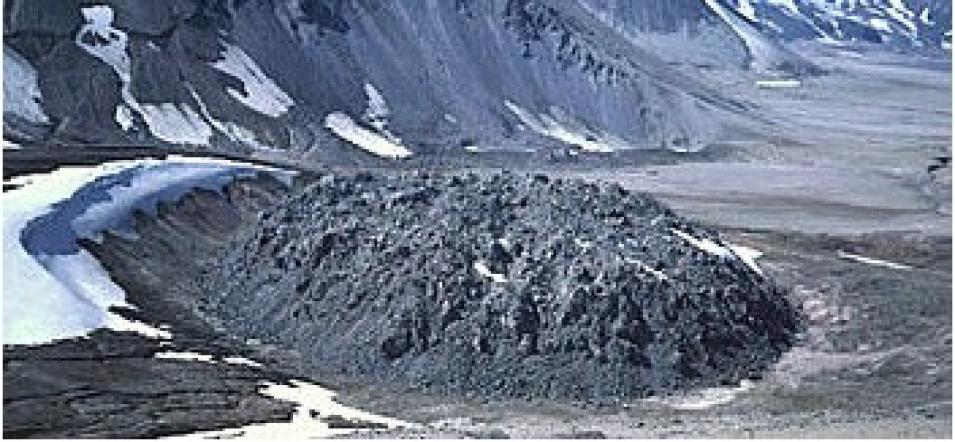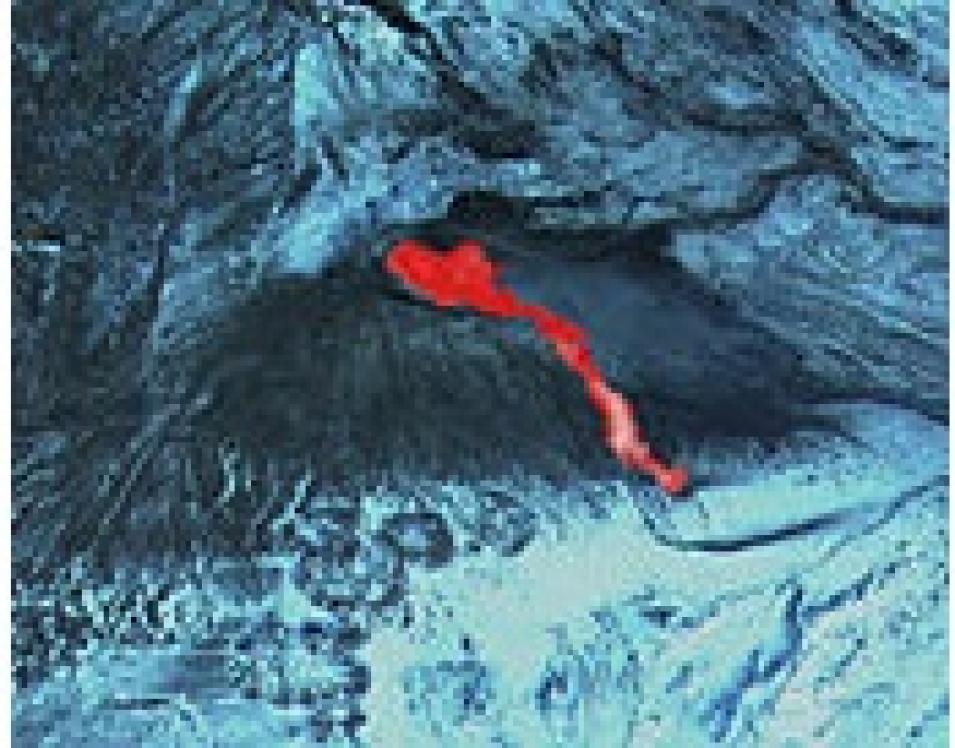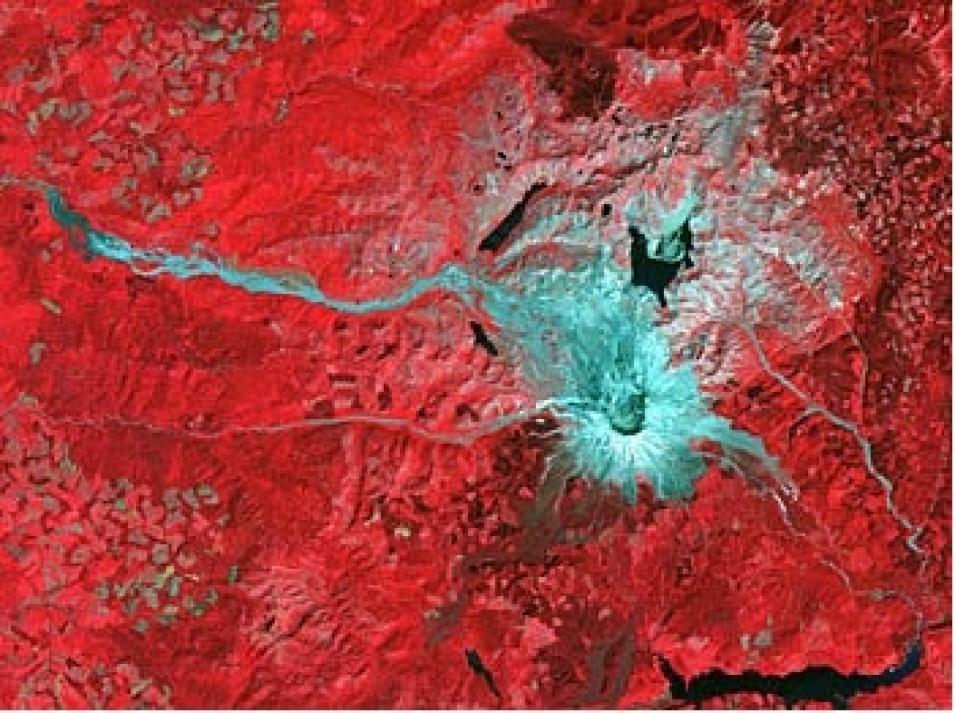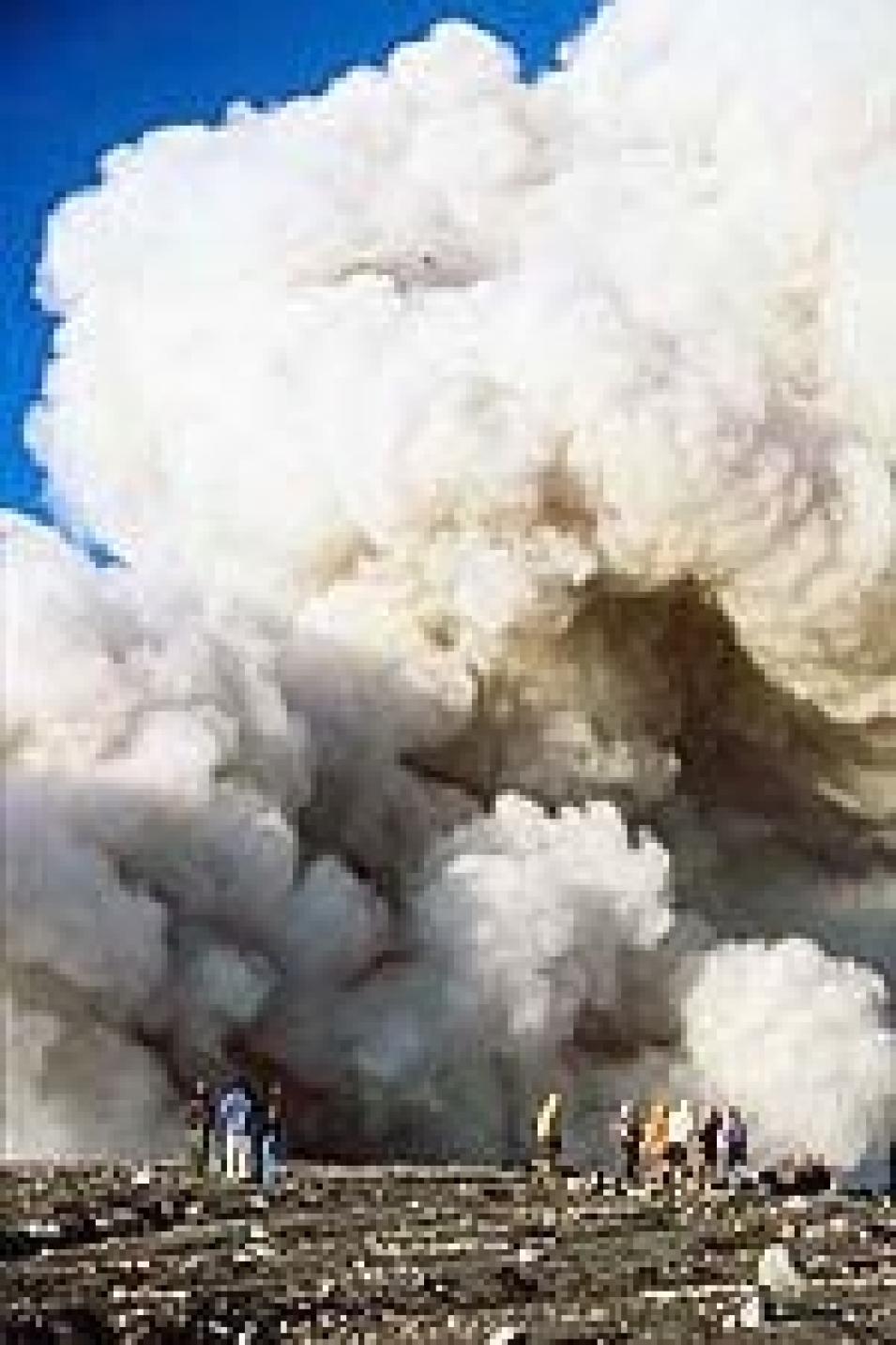In Japan, Mount Unzen is synonymous with disaster. In 1792, the volcano spawned the worst eruption catastrophe in Japanese history when its dome swelled and then collapsed, generating a massive landslide and tsunami that killed an estimated 15,000 people.
Domes of Destruction
The collapse of the Unzen volcanic dome in Japan created a pyroclastic flow of shattered lava fragments, volcanic gas, and air. A faster moving ash-cloud surge formed above and in front of the flow. Ash and hot gas then formed an eruption column. (Image adapted from the USGS Volcano Hazards Program).
Nearly 200 years later, in 1990, Mount Unzen began sputtering again. Between 1991 and 1994, scientists recorded approximately 10,000 pyroclastic flows on Unzen’s flanks, some of which traveled up to 5.5 kilometers (3.4 miles) from the dome. By summer 1993, these surges of hot ash and gas had destroyed more than 2,000 buildings in Shimabara City, situated beneath the volcano.
Some of the most destructive eruptions have been associated with volcanic domes. To ensure public safety, Japanese officials continually work to improve warning systems and evacuation plans. But volcanic domes, which form when magma squeezes its way out of a crater vent and piles up into a muffin-shaped form, often don’t send any clues until too late. To complicate matters, domes often form quickly — geologically speaking. The dome on Mount St. Helens in the Pacific Northwest U.S., for example, grew from 16 feet high and 82 feet in diameter to 164 feet high and 606 feet in diameter in just 24 hours.
Now, scientists are exploring the use of satellite data to monitor volcanic domes, which could lead to earlier detection of predictive changes in dome structure.
“Typically, after a large eruption, a dome develops and acts like a cork,” said Michael Ramsey, Assistant Professor of Geology and Director of the Image Visualization and Infrared Spectroscopy Laboratory at the University of Pittsburgh. “Sometimes the dome cools and that’s the end of it. But more often, the dome keeps growing and pressurizing until it collapses and generates pyroclastic flows and mudflows, which are very hazardous.”
Mount Unzen’s reawakening produced a new lava dome at its summit. “It was the worst-case scenario — where the dome actually grew up over the crater and hung off the side,” said Ramsey. “As the dome continued to grow, it became more unstable, and the front section would collapse and generate huge pyroclastic flows that caused devastation to the homes and farms below. Then the dome would re-build itself and repeat the whole process.”
According to Ramsey, pyroclastic flows are the most violent of volcanic eruptions. Highly mobile, these flows reach velocities of up to 400 kilometers (250 miles) per hour and can spread as far as 100 kilometers (60 miles) from the eruption point. In 1902, 29,000 people on the Caribbean island of Martinique were killed when a pyroclastic flow devastated the city of St. Pierre.
Pyroclastic flows also have the potential to unleash deadly lahars, or mudflows, during heavy rainstorms. Between August 1992 and July 1993, lahars from Mount Unzen damaged about 1,300 houses along the Mizunashi and Nakao Rivers, requiring the sudden evacuation of several thousand residents.
The first sign of a potentially active volcano is a hot spot — an area where hotter-than-average molten rock from the Earth’s mantle begins to move upward through the Earth’s crust. Where hot spots burn through the crust, volcanoes form.
A volcanic lava dome forms when lava erupts slowly and accumulates over the vent rather than flowing away. (Image courtesy of the USGS Lava Domes, Volcanic Domes, Composite Domes).
NASA’s newest satellite sensor, the Advanced Spaceborne Thermal Emission and Reflection Radiometer (ASTER), has unique capabilities that make it ideal for monitoring volcanic domes, Ramsey said. Launched aboard the Terra satellite in December 1999, the ASTER instrument captures images at a spatial resolution that ranges from 15 to 90 meters.
“ASTER is the only instrument on the Terra satellite that was designed to look at land processes involving small-scale surface change,” Ramsey said. “One of its channels actually looks off in a different direction, so it images the same ground point from two different angles. This allows us to make 3D digital elevation models of the Earth’s surface. What I hope to do is use ASTER in the ‘zoom lens’ mode, so that after initial eruptions are detected by other observatory programs, we can then schedule ASTER data to get detailed, high-resolution scenes.”
Ramsey and his colleagues work with the Alaska Volcano Observatory (AVO) to regularly monitor volcanoes in the Aleutian region, as well as all of the Kamchatka Peninsula volcanoes in Russia. “These are all very dangerous to aircraft, because when they erupt — the plumes head straight out over the Pacific,” Ramsey said.
Taken on December 28, 2000, this composite ASTER image shows the active Russian volcano Bezymianny. The volcano's topography appears in blue, and a thermal infrared image of the "hot spot" in red. Click here for more information.
ASTER data, available from NASA’s Land Processes Distributed Active Archive Center (LP DAAC), located at the U.S. Geological Survey EROS Data Center, has already proven its potential value, during an eruptive phase of Bezymianny Volcano that occurred between June and December 2000. “There were some periods when AVO saw no activity, because the thermal anomaly was too small to be captured in an image. But ASTER detected the hot spot, pyroclastic flows, and debris flows coming off the dome,” Ramsey said. “So we were able to map a lot more detail than AVO could.”
“We’re looking at how well we can use ASTER to monitor a volcanic dome surface, including temperature, chemistry, and texture, over a period of six months to a year. If we can predict upcoming eruptions, we can help mitigate potential hazards to people living below the volcano.”
Around the globe, about 100 volcanoes erupt during any given year, and millions of people live directly below many of these volcanoes. Mount St. Helens, which towers over a large, metropolitan population, has flow paths leading directly to urban areas. Mount St. Helens’ eruption on May 18, 1980, eliminated 1,300 feet of its summit, spewing ash up to 950 miles eastward and leaving 57 people dead.
“Mount St. Heles had a large eruption, and then for the next five to six years a lava dome grew in the crater, spawning small to moderate-sized eruptions as the dome collapsed or blew apart,” said Ramsey. “If ASTER data had been available to us back then, it would have been an excellent case study.”
Although detecting hot spots in the imagery is key, Ramsey takes his efforts a step farther and uses ASTER’s multispectral information to study the chemistry of volcanic domes. “As a geologist, I can look at the dome and determine not only the lava type, but also whether the type is changing over time,” he said. He can also determine the lava’s surface texture and examine bubbles in the lava. “This is important, because those bubbles indicate the potential explosivity of a future eruption. It’s like shaking a champagne bottle, and the dome represents the cork on the bottle,” he said.
ASTER acquired this image of Mount St. Helens on August 8, 2000. The image covers an area of 37 by 51 km. (Image courtesy of ASTER Image Gallery of Mount St. Helens).
“These are the subtle things that can’t be seen from other satellite sensors, and they certainly can’t be seen through ground-based monitoring,” Ramsey said. “You just can’t have somebody walk up to the dome to collect samples when an active eruption is going on.”
Ramsey knows firsthand the dangers of monitoring a volcano on-site. In July 2000, he was accompanying a team of scientists on a routine, weekly monitoring tour of Mt. Semeru in eastern Java when an eruption caught the group off guard. Although the eruption lasted only about 45 seconds, it left two Indonesian volcanologists dead and three Americans, including Ramsey, injured. Ramsey said he still has difficulty coping with the ordeal. “I’m better with it now, but for the first year after it happened, I had a hard time talking about it,” he said.
Ramsey hopes that his work with ASTER imagery will play an important role in mitigating volcanic hazards. “The mitigation effort would include working with a volcano observatory that’s monitoring the volcano or a series of volcanoes,” he said. “The hope is that I would detect some kind of change in the ASTER imagery, then I would let them know what that change might mean. They could then broadcast the information to nearby cities or to the Federal Aviation Administration.”
“We’re really in a tool-building mode. It’s a brand new satellite and a brand new data set that we’ve never had before. The question is, how well can we use these data to mitigate volcanic hazards?”
References
Corcoran, T. 1988. Mount St. Helens: The Story Behind the Scenery. KC Publications, Las Vegas, NV.
Spice, B. 2000. Volcanologist was caught off-guard by eruption. Post-Gazette.com. Accessed March 26, 2002.
USGS/Cascades Volcano Observatory Unzen Volcano, Japan. Accessed February 14, 2002.
USGS Volcano Hazards Program Dome Collapses Generate Pyroclastic Flows, Unzen Volcano, Japan. Accessed February 14, 2002.
Volcano Research Center, University of Tokyo Unzen — Decade Volcano, 1990-1995 Eruption Chronology. Accessed February 14, 2002.
For more information
NASA Land Processes Distributed Active Archive Center (LP DAAC)
NASA Advanced Spaceborne Thermal Emission and Reflectance Radiometer (ASTER)
Image Visualization and Infrared Spectroscopy (IVIS) Laboratory, Univ. of Pittsburgh
| About the remote sensing data used | ||
|---|---|---|
| Satellite | Terra | |
| Sensor | Advanced Spaceborne Thermal Emission and Reflection Radiometer (ASTER) | |
| Parameter | volcanic domes | |
| DAAC | NASA Land Processes Distributed Active Archive Center (LP DAAC) | |
